Home | Tours | Trip Reports | News | Team | Calendar | Links | Contact | Store | Mailing List

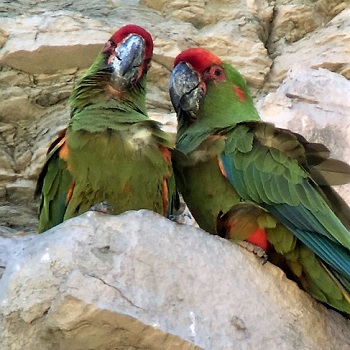 BOLIVIA!
BOLIVIA!with Diego Calderon
October 29 - November 13, 2024
PLUS:
Pre-tour,
Barba
Azul Nature Reserve
for Blue-throated
Macaw
October 25 - 30, 2024
PLUS:
Post-tour, Apolo
for the new Inti Tanager
November 13 - 19, 2024
Contact [email protected] to reserve your space!
Trip
Cost & Travel
Planning> Registration
Form (pdf)>
Tour
Registration, Terms,
Cancellation Policies
BOLIVIA! Welcome to the birdiest landlocked country in the world! Approximately the size of France and Spain combined, this stunning country is remarkably diverse and ranks 6th in the world with more than 1430 species of birds. Depending on the taxonomy you use, Bolivia has 20 endemic bird species that are found nowhere else on earth. Add to that more than 100 range restricted species and near endemics and you’ve just scratched the surface of Bolivia’s avian riches.
Long
known to avid
birders as a MUST
VISIT destination,
we will be exploring
this diverse,
bird-filled country
with South
America’s
top guide, Diego
Calderon.
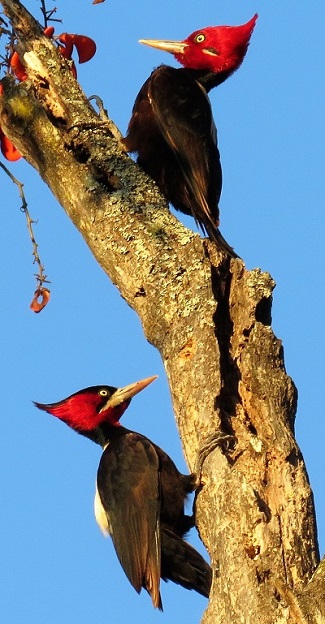 We
have designed
this
tour to offer
the full
Bolivia birding
experience
in three parts,
a pre-tour
extension for
the critically
endangered Blue-throated
Macaw in north-central
Bolivia, the
main 16
day tour visiting
all
of the top
birding sites
including
the
Red-fronted
Macaw Ecolodge,
and
a
special
post tour
extension
to Apolo for
the newly
discovered
"Inti" Tanager.
We
have designed
this
tour to offer
the full
Bolivia birding
experience
in three parts,
a pre-tour
extension for
the critically
endangered Blue-throated
Macaw in north-central
Bolivia, the
main 16
day tour visiting
all
of the top
birding sites
including
the
Red-fronted
Macaw Ecolodge,
and
a
special
post tour
extension
to Apolo for
the newly
discovered
"Inti" Tanager.
Just imagine adding species like Black-hooded Sunbeam, Bolivian Earthcreeper, Black-throated Thistletail, Berlepsch’s Canastero, Bolivian Recurvebill, Cliff Parakeet, Yungas Tody Tyrant, Bolivian Brushfinch, Bolivian Blackbird, Cochabamba Mountain Finch, Black-throated Thistletail, Unicolored Thrush, Grey-bellied Flowerpiercer, and more to your life list. Endemics, near-endemics and specialties, such as Short-winged (Titicaca) Grebe, Red-tailed Comet and Hooded Mountain Toucan will be targeted among many others.
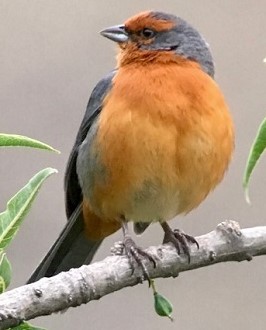
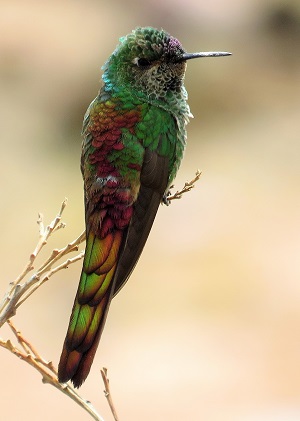
Photos:
Red-fronted Macaw (DC),
Cream-backed Woodpeckers
(GN), Cochabamba Mountain
Finch
(DC), Red-tailed Comet
(GN)
Join us for an unforgettable birding adventure in Bolivia!
Contact [email protected] to reserve your space!
Trip Cost & Travel Planning> Registration Form (pdf)> Tour Registration, Terms, Cancellation Policies>
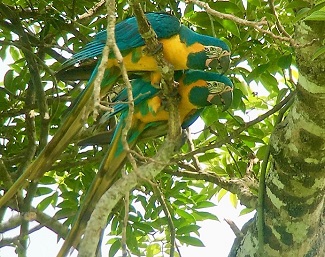 Pre-tour
Extension, October 25 - 30, 2024
Pre-tour
Extension, October 25 - 30, 2024
Barba
Azul Reserve/Blue-throated
Macaw
ITINERARY
Day
1:
Plan
on Arriving at Viru Viru
International Airport
in Santa Cruz, Bolivia
(airport code: VVI) today
for an overnight in the
modern Camino Real Hotel
in the city's elegant,
secure and thriving business
district. Night Santa
Cruz. No meals are included
today.
Days
2 & 3:
Today
we take a charter flight
to Trinidad, a bustling
town in the Llanos de
los Moxos in the department
of Bení,
sometimes referred to
as “bountiful
Bení” for
its diverse woodlands,
riparian forests,
sprawling
grasslands and palm
savannahs.
Continuing on to Barba
Azul Nature Reserve,
we will focus our
efforts
on finding the star
of
the Moxos, the 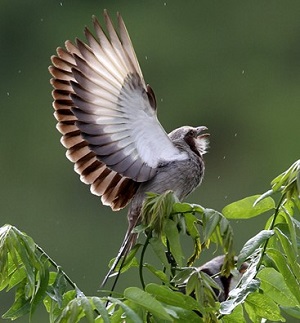 rare
and
critically endangered
Blue-throated
Macaw (DC) .
Thought to be extinct
in the wild and known
only from museum specimens
and captive birds until
the mid-1990s, conservation
efforts have increased
the wild population
of
these superb birds
to
450.
rare
and
critically endangered
Blue-throated
Macaw (DC) .
Thought to be extinct
in the wild and known
only from museum specimens
and captive birds until
the mid-1990s, conservation
efforts have increased
the wild population
of
these superb birds
to
450.
We’ll
search for the Blue-throated
Macaw, also called Barba
Azul and designated in
2014 as a natural patrimony
of Bolivia, in the islands
of palm trees that dot
the expansive seasonally
flooded savannah grasslands
from our base at the Barba
Azul Nature Reserve. This
important Reserve protects
27,180 acres of important
grassland, wetland, and “palm
island” habitat
and houses more than 250
species of birds and nearly
30 large mammal species
including Giant Anteater,
Pampas Cat, Puma, Maned
Wolf, and Jaguar. The
variety of habitats here
are what make Bení bountiful
with wetland habitats
attracting hordes of water
birds making for a spectacle
reminiscent of Brazil’s
Pantanal.
In
our search for Blue-throated
Macaw, we will also
keep
watch for myriad birds
and specialties here
including Streamer-tailed
Tyrant (SB),
Crowned Eagle,
Orinoco Goose, Cinereous-breasted
Spinetail, Sulphur-bellied
Tyrant-Manakin, Hudson’s
Black-Tyrant, and
Dark-throated
Seedeater to name
a
few. Two nights
BTM Reserve.
Day
4
Today
we will return to Trinidad
and spend some time
birding
the area noted by some
as the “best
birding city in the world”.
Our time here will be
spent well, especially
looking for three Bení endemics.
While we may be distracted
by Chestnut-fronted Macaws
roosting in the church
steeple or Blue-and-yellow
Macaws flying around the
outskirts of the city,
our objective near Trinidad
is to try and see the
endemic Unicolored Thrush,
Bení Softtail
(still recorded as Plain
Softtail) and the Bení Grackle
(still recorded as the
Velvet-fronted Grackle).
With luck, these birds
can be found in the riparian
forest of San Ramon.
Night Trinidad.
Day
5
Today
we return to Santa Cruz
to meet the group arriving
for the main tour.
Pre-tour
Extension to the Barba
Azul Nature Reserve/Blue-throated
Macaw, October 25 - 30, 2024
Tour
Price: $3095
pp/dbl
$295 sgl
from
Santa
Cruz,
Bolivia
based
on
8
passengers.
Included: Group
airport
transfers,
accommodations,
domestic
flight
to
Trinidad,
Bolivia,
Charter
flight
to
BTM,
ground
transport
in
local
vehicles. Not
included: International
flight,
luggage
charges,
passport/visa
fees,
insurance,
drinks,
tips,
and
items
of
a
personal
nature.
Also,
any
and
all
costs
arising
from
pandemic
or
Covid-19
related
issues
are
not
included
in
the
tour
cost
and
are
the
sole
responsibility
of
the
traveler.
These
include,
among
others,
the
costs
of
Covid
treatment,
hospitalization,
medical
fees,
transport,
meals
and
accommodation
in
case
of
illness
or
quarantine,
and
the
costs
of
any
Covid
tests
needed
before,
during
and
after
the
tour.
BOLIVIA
MAIN TOUR, October 29 - November 13, 2024
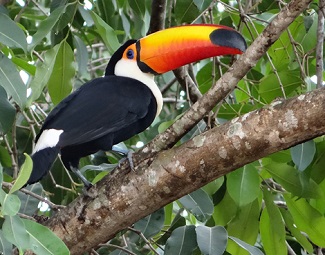 Day
1
Day
1
Plan
on arriving this morning
at Viru Viru International
Airport in Santa Cruz,
Bolivia (airport code:
VVI). Many flights arrive
in the morning and if
everyone arrives by mid-day,
we will do some afternoon
birding and have an introduction
to Bolivia’s
avian treasures. Santa
Cruz de la Sierra is a
lowland city surrounded
by native woodlands of
acacia-like trees and other
xerophytic vegetation (the
Chiquitania region) and
vast grassland plains and
savannas reminiscent
of the Brazilian cerrado.
This diverse area offers
several bird species endemic
to and typical of this
ecosystem such as Toco
Toucan (GN),
White-wedged
Piculet, Chotoy Spinetail,
Chopi Blackbird, White
Woodpecker, White-bellied
Nothura, Red-winged Tinamou,
Red-legged Seriema, Green-cheeked
Parakeet, the near-endemic
Bolivian Slaty Antshrike,
and others. The botanical
garden at Santa Cruz is
a key sight for the Bolivian
Slaty-Antshrike.
Night
Santa
Cruz.
Day
2
This
morning we will bird
around Santa Cruz and
Lomas de Arena Municipal
Park. The Park was created
to protect a small lake
between sand dunes and
several types of habitats
are preserved in the
area
including savannah, dry
forest, marshes and large
water bodies. We will
hope the park is accessible
as high water levels
sometimes impact access. More
than
240 species of bird have
been recorded in the
park and the area has
many easily seen and desired
birds such as Comb Duck,
Brazilian Duck, Burrowing
Owl, White-eared Puffbird,
White Woodpecker, Chalk-browed
Mockingbird, and Chotoy
Spinetail. It also offers
some less common species
like Toco Toucan and
Red-legged
Seriema. Other
species in the habitats
around Santa Cruz include
Small-billed Tinamou,
Long-winged Harrier,
Blue-winged Parrotlet,
Thrush-like
Wren, Masked Yellowthroat,
Stripe-backed Antbird,
Straneck’s
(grey-crowned or monte)
Tyrannulet, Blue-crowned
Trogon, Amazonian Motmot,
Buff-bellied Hermit,
Red-billed Scythebill,
Narrow-billed Woodcreeper,
Stripe-backed and Mato
Grosso Antbirds, Plush-crested
Jay, Ringed
Teal (GN),
and Whistling Heron.
From Santa Cruz, we start our drive towards the inter-Andean valleys, on the way passing through the lush tropical forest of the Bermejo canyon. We will seek out the species of the forest and canyon such as Bolivian White-crowned Tapaculo, Grey-throated Leaftosser, Military Macaw, Rufescent Screech Owl, Two-banded Warbler, Dusky-green Oropendola, and more.
Our
accommodation is Refugio
Los Volcanes, a wonderful
lodge located in a
mystical
place on the edge of
Amboro National Park.
Situated at the intersection
of three major South
American
biogeographic regions,
its bird community
presents
a unique mixture of
elements
from southern Amazonia,
the central Andes,
and
the Chaco. This results
in a high diversity
of
species, largely a
result
of the variability
of
the forest, which ranges
from completely deciduous
on the driest slopes
to nearly evergreen
in
a humid, south-facing
canyon.
Species
possible at the southern
edge of Amboro National
Park include Andean Condor,
King Vulture, Bolivian
Recurvebill (rare), Slaty
Gnateater, Bolivian
Tapaculo,
and Yungas Manakin.
More
common and widespread
species include Blue-headed
and Red-billed Parrots,
Grey-rumped, Chestnut-collared
Swifts, Sparkling Violetear,
Fork-tailed Woodnymph,
White-eared Puffbird,
Chestnut-tipped Toucanet,
Chestnut-eared Aracari,
Red-necked Woodpecker,
Black-banded and Tschudi’s
Woodcreepers, Plain
Antvireo, White-backed
Fire-eye, Sepia-capped
and Slaty-capped Flycatchers,
and White-necked Thrush.
Mixed flocks may well
produce Tropical Parula,
Slate-throated Whitestart,
Guira, Black-goggled,
White-winged, and Saffron-crowned
Tanagers, Blue-naped
Chlorophonia (SB),
and Thick-billed
and Golden-rumped
Euphonias.
Higher elevation forests
may produce the Short-tailed
Antthrush. A beautiful
crater lake, surrounded
by dense reed beds,
usually holds one
or two family parties
of Masked Duck. Night
Refugio Los Volcanes.
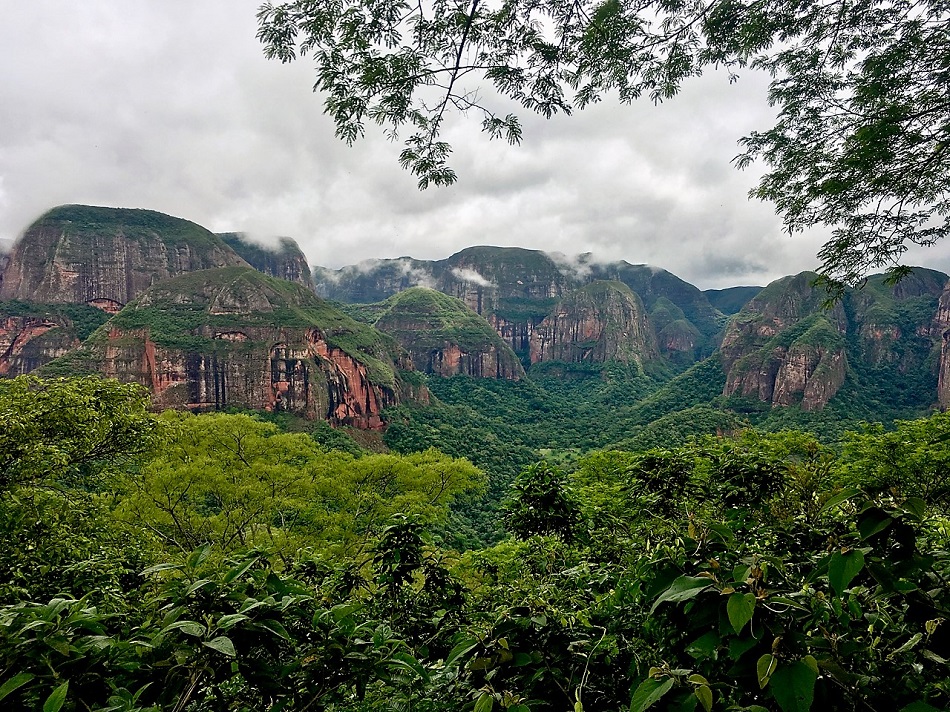
Los
Volcanes (Photo: Diego
Calderon)
Day
3
Today
we have the full day
to explore the area around
Los Volcanes and Amboro
National Park. Volcanes
is a misnomer as there
are no volcanoes here,
just scenic valleys,
sandstone mesas, and
semi-humid
forest of the Amazonian
foothills. Once again
the assortment of habitats
offer a variety of species
and we will be looking
for everything from Two-banded
Warbler, to Black-goggled
Tanager, Dusky-green
Oropendola, Plush-crested
Jay (GN),
Purplish Jay, Masked
Duck, Green-cheeked
Parakeet, Blue-throated
Piping-Guan, and many
others. With more than
270 species logged
in
the surrounding area,
we will have plenty
to look for in and
around
the park.
Some
species possible at
the
southern edge of Amboro
National Park include
Giant Antshrike, Bolivian
Earthcreeper, Glittering-bellied
Emerald, Blue-and-white
Swallow and Blue-and-yellow
Tanager as well as
Blue-crowned
Parakeet, White-fronted
and Striped Woodpeckers,
Stripe-crowned Spinetail,
White-bellied Tyrannulet,
Greater Wagtail-tyrant,
Pearly-vented Tody-tyrant,
White-tipped Plantcutter,
Ringed and Black-capped
Warbling-finches, Grey-crested
Finch, Red Pileated
Finch
and Golden-billed Saltator.
Night Refugio Los Volcanes.
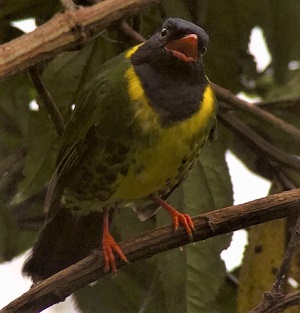 Day
4
Day
4
Today
we will explore all
the
dry valleys of Amboro
between Samaipata
and
Saipina in search
of
some very special
birds.
Several Bolivian endemics
can be found here
and
we hope to find Bolivian
Earthcreeper, Bolivian
Blackbird, and Cliff
Parakeet. Other species
include Dusky-legged
Guan, Giant Antshrike,
Grey-crested Finch,
and
both Chaco and White-eared
Puffbirds, among others.
Star
species here include
a number of endemics
such
as Bolivian Warbling
Finch, Light-crowned
Spinetail,
Grey-bellied Flowerpiercer,
Trilling Tapaculo,
hummingbirds
such as Red-tailed
Comet,
Violet-throated Starfrontlet,
Scaled and Tyrian Metaltails,
plus Bar-bellied and
Montane Woodcreepers,
Pearled Treerunner,
Spot-breasted
Thornbird, Montane
Woodcreeper,
Olive-crowned Crescentchest,
White-throated Tyrannulet,
Andean Tyrant, Rufous-breasted
Chat-tyrant, Scarlet-bellied
and Chestnut-bellied
Mountain Tanagers,
Blue-backed
Conebill, Rufous-naped
Brushfinch, Buff-banded
Tyrannulet, Bolivian
Brushfinch, Bar-bellied
Woodpecker, and Band-tailed
Fruiteater (DC).
At the end
of the day, we will
have
arrived at our accommodation
in Psada del Sol.
Night
Psada
del Sol.
Days
5 & 6:
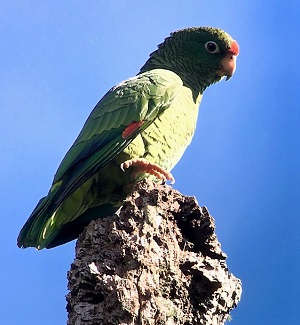 This
morning we drive to
Quirusillas
to bird the Tucuman
Forest.
There should
be plenty of Andean
Condors
to see (Bolivia's
national bird), and
when
we arrive in this
unique, moist
mountain
forest surrounded
by
dry Andean Valley
Habitat,
we will look for the
Tucuman
Parrot (DC).
This area
is the furthest northern
point for the Tucuman
Parrot and the
area is quite remarkable.
This humid mountain
peak
in the dry landscape
holds
the northern most remnants
of Tucuman forest. It
is
famous
for its “alder”,
Podocarpus pine trees
and hence the local
name
of this parrot - Loro
Pinero (Alder Parrot). Other
species to see here
include White-throated
Antpitta, Golden-winged
Cacique, Straw-backed
Tanager, Short-tailed
Antthrush, Raquet-tailed
Puffleg, and White-throated
Quail-dove.
This
morning we drive to
Quirusillas
to bird the Tucuman
Forest.
There should
be plenty of Andean
Condors
to see (Bolivia's
national bird), and
when
we arrive in this
unique, moist
mountain
forest surrounded
by
dry Andean Valley
Habitat,
we will look for the
Tucuman
Parrot (DC).
This area
is the furthest northern
point for the Tucuman
Parrot and the
area is quite remarkable.
This humid mountain
peak
in the dry landscape
holds
the northern most remnants
of Tucuman forest. It
is
famous
for its “alder”,
Podocarpus pine trees
and hence the local
name
of this parrot - Loro
Pinero (Alder Parrot). Other
species to see here
include White-throated
Antpitta, Golden-winged
Cacique, Straw-backed
Tanager, Short-tailed
Antthrush, Raquet-tailed
Puffleg, and White-throated
Quail-dove.
In
the afternoon, we will
continue to the Red-fronted
Macaw Preserve where
we will spend some time
looking for the endemic,
critically endangered
Red-fronted Macaw. Less
than two feet long,
what
this bird lacks in size
is made up for by its
colorful plumage. Its
bright red forehead
and
underwings are set off
by a brilliant green
body, orange epaulets,
and blue wings and tail.
Less than 3000 of these
birds survive in the
arid canyons of the
central
Bolivian Andes. While
most macaws nest in
tree holes, few trees
exist here so this bird
nests in cliff faces.
We’ll
be watching for birds
flying overhead as well
as scanning the cliff
faces for perched birds.
With luck, we hope to
get good views of this
unique bird. 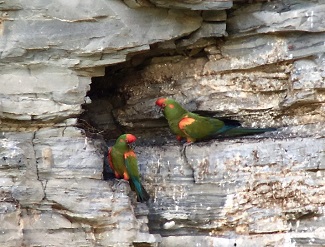
We will stay on the reserve in the Red-fronted Macaw Ecolodge which helps protected the Macaw, with all proceeds go to the local communities and the protection of the Reserve. The general opinion of the Ecolodge is "fantastic". The lodge is situated across the river from a massive hard rock breeding cliff which serves as the most important breeding area for the Red-fronted Macaw (DC). Bolivian Cliff Parakeet (a different form of the Monk Parakeet), Mitred Parakeet, and Bolivia Blackbirds (endemic) are also found here and you'll soon see that this desert habitat holds a regional specific bird community, with such distinctive species as the White-eared Puffbird, Greater Wagtail Tyrant, White-tailed Plantcutter, Grey-crested Finch, Spot-fronted Woodpecker, Aplomado Falcon, Ultramarine Grosbeak, and Cliff Flycatcher. During the Red-fronted Macaw breeding season (November- to early May) the macaws are constantly present, seen flying in pairs, families, and groups so we will be here at the perfect time! Two nights Red-fronted Macaw Ecolodge.
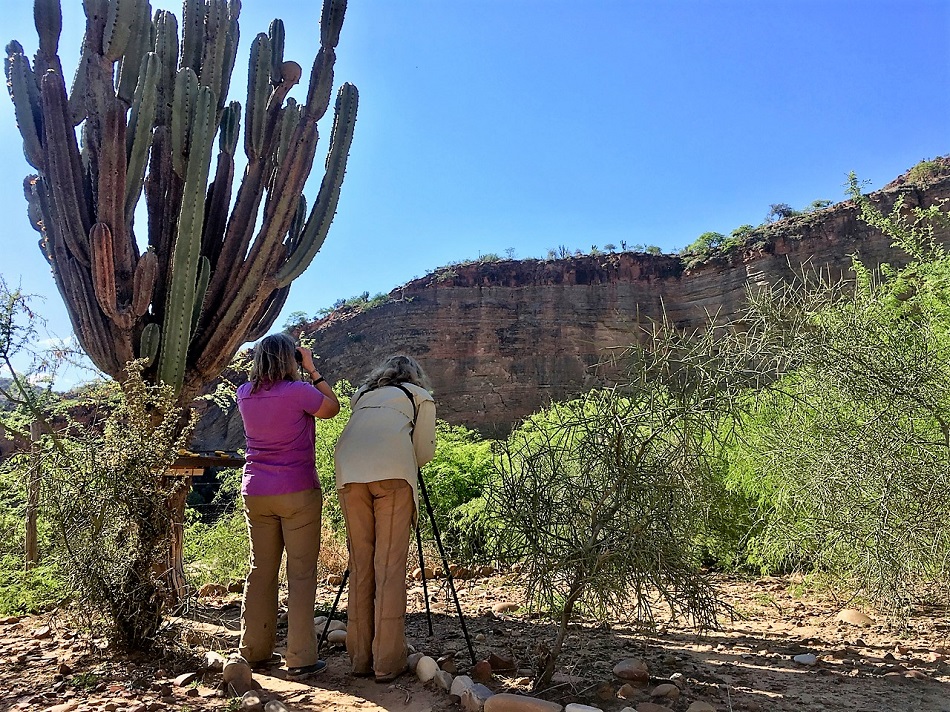
Watching
Red-fronted Macaws!
(DC)
Days
7 - 11
Today
we travel from Comarapa
to passing through
the
famed Siberia cloud
forest
on our way to Cochabamba.
As we rise in altitude,
we’ll
look for Black-throated
Thistletail and Black-hooded
Sunbeam in elfin
forest
patches as well as
a variety of warbling
finches on the high
Andean plateau.
Other species to
look
for here include
Wedge-tailed
Hillstar, Rufous-bellied
Saltator, Citron-headed
Yellow-Finch, White-tipped
Plantcutter, Great
Pampa-Finch,
Cinereous Harrier,
Black-chested
Buzzard-Eagle, Tawny-throated
Dotterel (SB),
Bare-faced Ground-Dove,
Giant Hummingbird,
Slender-billed
Miner, Cream-winged
Cinclodes,
Brown-capped Tit-Spinetail,
Creamy-breasted
Canastero,
Tufted Tit-Tyrant,
Rufous-webbed
Bush-Tyrant, Brown-bellied
Swallow, Rusty-browed
Warbling Finch
and Greenish
Yellow-Finch.
The city of Cochabamba, in the center of the country at 2550 meters (8366 feet) above sea level, will be our base for the next few days to explore the slopes of Cerro Tunari, where several endemics occur, such as Cochabamba Mountain Finch and Bolivian Warbling Finch. There is so much to explore in the varied habitats around Cochabamba and over the next several days we will bird the forests of the Amazonia slope as well as the arid temperate scrub, Polylepis woodlands, and puna grasslands.
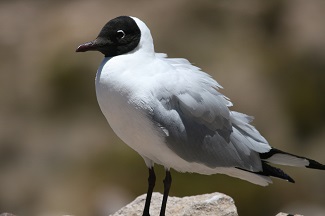 The
Polylepis woodland
habitat
is unique and offers
the gorgeous Red-tailed
Comet and several Polylepis
specialists including
Tawny Tit-Spinetail,
Brown-capped Tit-Spinetail,
and Giant Conebill.
Star
species here include
Black-hooded
Sunbeam, Wedge-tailed
Hillstar, Maquis (or
Iquico) Canastero,
Rufous-bellied
Saltator, Cochabamba
Mountain-Finch, Citron-headed
Yellow-Finch, Bolivian
Blackbird. Other species
we may find include
Rufous-sided
Warbling Finch (relatively
common), Maquis
Canastero,
Rock Earthcreeper,
and
Black-hooded Sierra-Finch.
The
Polylepis woodland
habitat
is unique and offers
the gorgeous Red-tailed
Comet and several Polylepis
specialists including
Tawny Tit-Spinetail,
Brown-capped Tit-Spinetail,
and Giant Conebill.
Star
species here include
Black-hooded
Sunbeam, Wedge-tailed
Hillstar, Maquis (or
Iquico) Canastero,
Rufous-bellied
Saltator, Cochabamba
Mountain-Finch, Citron-headed
Yellow-Finch, Bolivian
Blackbird. Other species
we may find include
Rufous-sided
Warbling Finch (relatively
common), Maquis
Canastero,
Rock Earthcreeper,
and
Black-hooded Sierra-Finch.
Puna
grasslands may yield
Short-tailed Finch
on
the rockiest slopes,
Puna
Canastero and a variety
of Ground Tyrant species
in grassier areas.
The
beautiful mountain
scenery
is a picture in itself
with images of Andean
Gull (JA),
Andean Goose,
and
Andean Lapwing.
The
cloud forest and upper
tropical foothills
around
Cochabamba hold several
range-restricted species
that are otherwise
found
only in the extreme
southeast
of Peru and are hard
to get there, such
as
Hooded
Mountain Toucan (DC),
Orange-browed Hemispingus,
and Yungas Tody-Tyrant.
We will also look
for
the endemic Yellow-rumped
Antwren, White-eared
Solitaire, Straw-backed
Tanager, Blue-banded
Toucanet,
Crested Quetzal,
and
more.
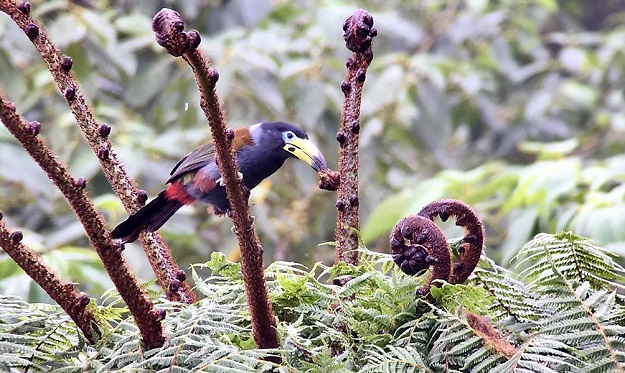
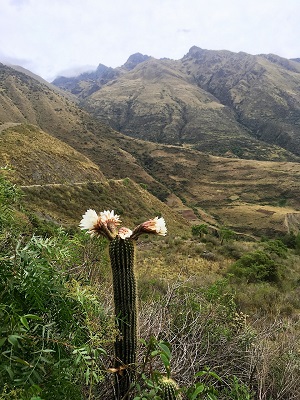
We’ll
spend time exploring
the Chapare area, home
of several exciting birds,
including Rufous-faced
Antpitta, Black-throated
Thistletail, Trilling
Tapaculo, White-eared
Solitaire, the localized
Hooded Mountain Toucan,
Masked Trogon, Superciliaried
and Orange-browed Hemispingus,
Band-tailed Pigeon, Barred
Antthrush, and Streaked
Xenops among many others.
Chapare
Road and the Yungas
of
Carrasco National Park
offer areas reminiscent
of La Siberia on the
other side of the Reserve.
We’ll
be looking for Black-winged
Parrot, Golden-headed
Quetzal, Blue-banded
Toucanet, Crimson-mantled
Woodpecker, and Hooded
Mountain Tanager at
higher elevation. As
time allows, we have
the lower elevations
to look for Speckled
Hummingbird,
Long-tailed Sylph,
Booted
Racket-tail, Versicolored
Barbet, Saffron-crowned,
Straw-backed and Beryl-spangled
Tanagers, White-eared
Solitaire, Andean
Cock-of-the-Rock,
and Green Jay. Other
specialties we may
see here include Black-throated
Thistletail, Bolivian
Tyrannulet, Band-tailed
Fruiteater (near-endemic),
Chestnut-crested Cotinga,
White-eared Solitaire,
the uncommon Straw-backed
Tanager and Pale-footed
Swallow as well as
White-throated
Antpitta. If we are
lucky
we may will find the
remarkable Torrent
Duck and the extraordinary
Sword-billed Hummingbird.
Nights Cochabamba.
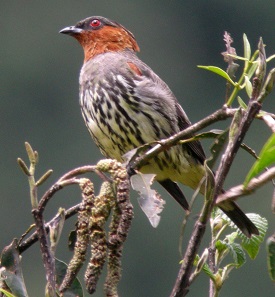
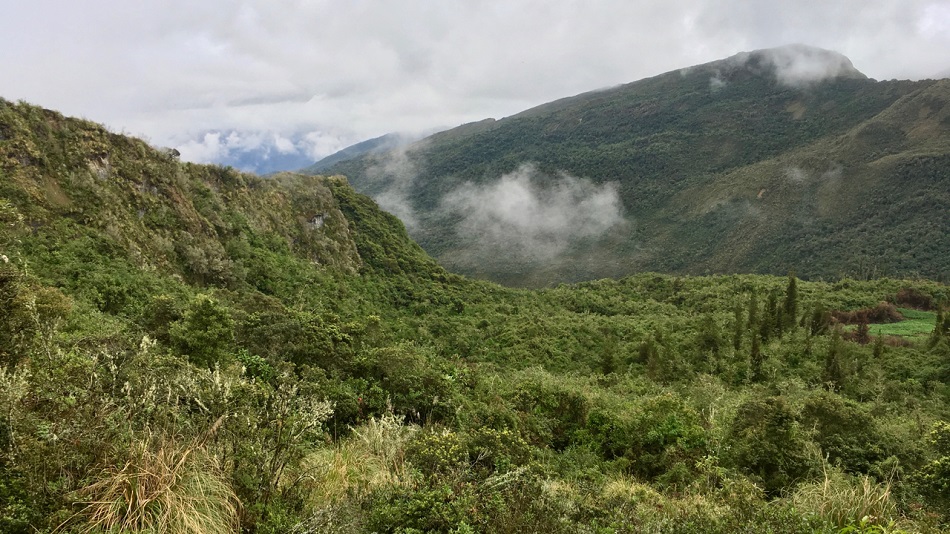
Photos:
Crimson-mantled Tanager
(GN), Sword-billed Hummingbird
(SB), Chestnut-crested
Cotinga (SB), Yungas
habitat (DC)
Day
12
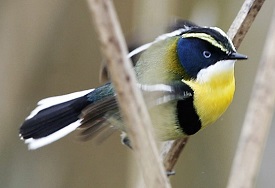 This
morning we’ll
bird Lake Alalay,
southeast
of Cochabamba and
another
key birding site
of the area. This
large lake sits
at 12,000 feet
and plays host
to a variety
of waterfowl including
White-tufted and
Silvery
Grebe, Cinnamon
Teal,
Yellow-billed Teal,
Puna Teal, Speckled
Teal, Red Shoveler,
White-cheeked
Pintail, Puna Ibis,
Andean Lapwing,
Andean Gull, Plumbeous
Rail, Andean Duck,
Andean Avocet,
and Slate-colored
Coot.
This
morning we’ll
bird Lake Alalay,
southeast
of Cochabamba and
another
key birding site
of the area. This
large lake sits
at 12,000 feet
and plays host
to a variety
of waterfowl including
White-tufted and
Silvery
Grebe, Cinnamon
Teal,
Yellow-billed Teal,
Puna Teal, Speckled
Teal, Red Shoveler,
White-cheeked
Pintail, Puna Ibis,
Andean Lapwing,
Andean Gull, Plumbeous
Rail, Andean Duck,
Andean Avocet,
and Slate-colored
Coot.
Reedbeds
around the lake harbor
Many-colored
Rush-Tyrant (SB)
and
Wren-like Rushbird.
Great Pampa-Finch
and
Grassland Yellow-Finch
are good finds here
and Bare-faced Ground-Dove,
Rufous Hornero, Bay-winged
Cowbird, Creamy-breasted
Thrush, Cream-winged
Cinclodes, Andean
Negrito,
and Yellow-winged
Blackbird
are all possible.
Later
in the day we board
our flight to La
Paz.
Night La Paz.
Day
13
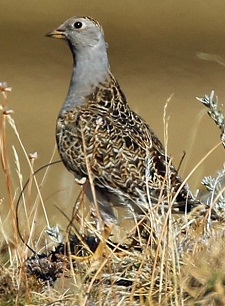 From
La Paz we will explore
two more sights: Lake
Titicaca to the north
and the Yungas valleys
to the east across
the
Andes. This morning
we
will head northeast
toward
the lush cloud forest
and foothills above
Coroico
town. We will drive
through
a spectacular Andean
mountain road that
has
become a paradise
for
birders and look for
species such as Rufous-bellied
and Grey-breasted
Seedsnipe (SB),
Scribble-tailed
Canastero,
and Giant Coot,
which
are mostly restricted
to the high passes
of
the mountains. We’ll
also descend to
the forest, where
many species are
possible, including
mega mixed flocks
of various more
wide-spread tanagers,
Barred and Band-tailed
Fruiteater, Versicolored
Barbet, Upland
Antshrike, Crimson-mantled
Woodpecker, Bar-bellied
Woodpecker, Hooded
Mountain Toucan,
Citrine Warbler,
Glossy-black Thrush,
Scarlet-bellied,
Chestnut-bellied
and Hooded Mountain
Tanagers, and many
more.
From
La Paz we will explore
two more sights: Lake
Titicaca to the north
and the Yungas valleys
to the east across
the
Andes. This morning
we
will head northeast
toward
the lush cloud forest
and foothills above
Coroico
town. We will drive
through
a spectacular Andean
mountain road that
has
become a paradise
for
birders and look for
species such as Rufous-bellied
and Grey-breasted
Seedsnipe (SB),
Scribble-tailed
Canastero,
and Giant Coot,
which
are mostly restricted
to the high passes
of
the mountains. We’ll
also descend to
the forest, where
many species are
possible, including
mega mixed flocks
of various more
wide-spread tanagers,
Barred and Band-tailed
Fruiteater, Versicolored
Barbet, Upland
Antshrike, Crimson-mantled
Woodpecker, Bar-bellied
Woodpecker, Hooded
Mountain Toucan,
Citrine Warbler,
Glossy-black Thrush,
Scarlet-bellied,
Chestnut-bellied
and Hooded Mountain
Tanagers, and many
more.
We
will also explore the
Andean bogs and stony
slopes near La Cumbre
pass (4,700 m), elfin
forest and paramo habitat
bordering Cotapata
National
Park. There is so much
to see here including
Scimitar-winged Piha,
Diademed Tapaculo,
Orange-browed
Hemispingus along with
an excellent variety
of tanagers and flycatchers.
Other birds in the
mid
and higher elevation
side valleys include
Scribble-tailed Canastero,
Puna Tapaculo, Black-billed
Shrike Tyrant, Puna,
Ochre-naped and White-fronted
Ground Tyrants, Short-tailed
Finch (rare) and Black
Siskin, Moustached
Flowerpiercer,
White-browed Conebill,
Mountain Cacique and
numerous hummingbirds.
Other birds of these
unique
habitats include
Golden-collared Tanager
and 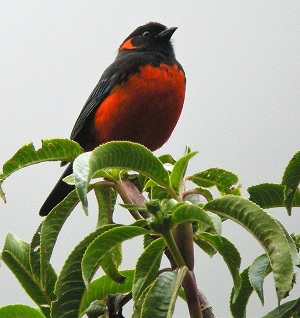 Black-throated
Thistletail,
Pale-footed Swallow,
Plum-crowned Parrot,
Versicolored Barbet,
Golden-olive Woodpecker,
Smoky-brown Woodpecker,
Upland Antshrike,
Torrent
Duck, White-capped
Dipper,
Stripe-chested Antwren,
tanagers and flycatchers
galore. Night Coroico.
Black-throated
Thistletail,
Pale-footed Swallow,
Plum-crowned Parrot,
Versicolored Barbet,
Golden-olive Woodpecker,
Smoky-brown Woodpecker,
Upland Antshrike,
Torrent
Duck, White-capped
Dipper,
Stripe-chested Antwren,
tanagers and flycatchers
galore. Night Coroico.
Day
14
We
will depart early
this
morning to reach the
best upper Yungas
and
high-elevation birding
areas en-route back
to La Paz. The scenery
is again of the spectacular
kind. The Yungas,
near
Unduavi, gives us
our
best chance at seeing
Yungas (large-tailed)
Doves, while Andean
Guan,
Yungas Pygmy Owl,
Citrine
Warbler, White-banded
Tyrannulet and Blue-backed
Conebill, Hooded Mountain
and Scarlet-bellied
Mountain
Tanager (SB)
should
all turn
up. Further gems
may
consist of White-collared
Jay, flocks of Southern
Mountain Cacique,
Scaled
and Tyrian Metaltails,
White-crested and
Sierran
Elaenias, the rare
Three-striped
Hemispingus, Barred
Fruiteater
or even Stripe-faced
Wood Quail. There
is
also the chance
to see
Hooded Mountain
Toucan.
This mythical creature,
which has led plenty
a fine birder on
a merry
chase through the
Andes
is certainly
not guaranteed,
but this
is one of the best
places
to find it. We
expect
to arrive in La
Paz in
the mid-afternoon,
where
a comfortable hotel
and
a good meal will
get
us ready for the
last
exciting days of
the
main tour. Night
La Paz.
Day
15
Today
we head to Sorata to
look for the endemic
and
localized Berlepsch’s
Canastero, Giant Coot
and other high-Andes
species including Huayco
Tinamou, Ornate Tinamou,
Black-winged Ground Dove,
Golden-spotted Ground
Dove, Scribble-tailed
Canastero, White-winged
Black Tyrant, Golden-billed
Saltator, Yellow-bellied
Siskin and Black-hooded
Sunbeam. This day will
also see us taking in
the area around Lake
Titicaca, the highest
navigable lake in the
world, located at 3800
meters (12,468 feet) with
a depth of 281 meters
(922 feet). Lake Titicaca
is the home of the endangered,
near-endemic, flightless
Titicaca (Short-winged)
Grebe. Ranging in size
from 11-17 inches, this
little grebe is unique
in that is has lost its
ability to fly. It spends
its time in the shallower
lake margins where we
hope to get good views.
We will also have a chance
to see Andean Avocet,
Chilean Flamingo, Puna
Teal, Crested Duck, Yellow-billed
Teal, and Many-colored
Rush Tyrant here. Night
La Paz.
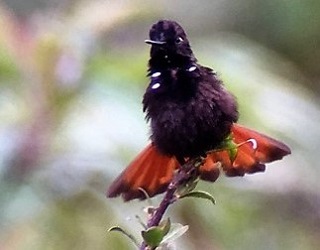
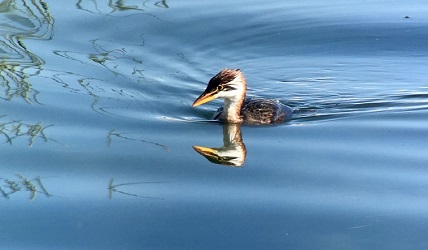
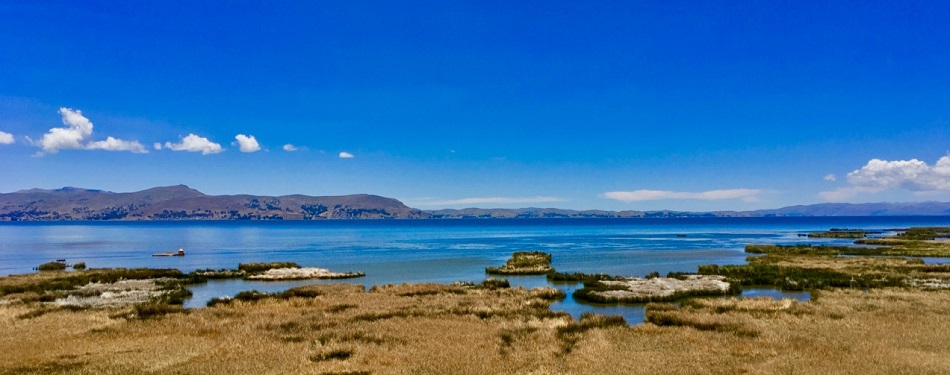
Black-hooded
Sunbeam, Titicaca Grebe,
Lake Titicaca (all DC)
Day
16
Today
we will say our goodbyes
and transfer to La
Paz/El
Alto International
Airport
(Code: LPB) to connect
with our international
flights home or continue
to Apolo for the Inti Tanager extension.
BOLIVIA
Main
16 day Tour, October 29 - November 13, 2024
Tour
Price:
$7095
pp/dbl,
$695
sgl
Note
this
tour
begins
in
Santa
Cruz,
Bolivia
and
ends
in
La
Paz,
Bolivia.
Price
is
based
on
8
passengers.
Included: Group
airport
transfers,
accommodations,
meals,
transportation
in
passenger
bus
Not
Included: International
flight,
luggage
charges,
passport/visa
fees,
insurance,
drinks,
tips,
and
items
of
a
personal
nature. Also,
any
and
all
costs
arising
from
pandemic
or
Covid-19
related
issues
are
not
included
in
the
tour
cost
and
are
the
sole
responsibility
of
the
traveler.
These
include,
among
others,
the
costs
of
Covid
treatment,
hospitalization,
medical
fees,
transport,
meals
and
accommodation
in
case
of
illness
or
quarantine,
and
the
costs
of
any
Covid
tests
needed
before,
during
and
after
the
tour.
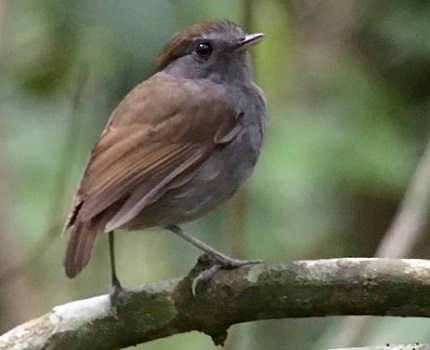
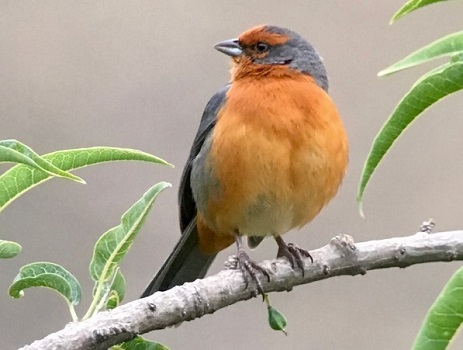
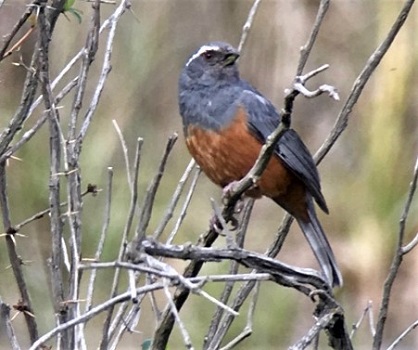
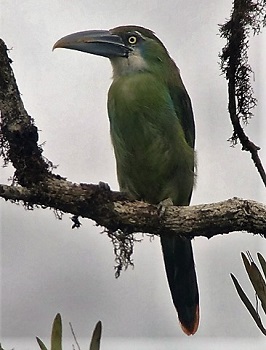
Slaty
Gnateater, Cochabamba
Mountain Finch, Rufous-bellied
Mountain Tanager, Blue-banded
Toucanet (all DC)
Post-tour
Extension Inti
Tanager, November
13 - 19, 2024
For
those who want more
adventure
we have organized
a very
special extension
to the Apolo-Atén
area to look for
the newly described Inti Tanager (DC).
First found in
the San
Pedro area on
the
Manu
road in Peru in
2000,
this new species
was known
as San Pedro Tanager,
and has recently been described and named. Our
tour
stages
from the town
of
Apolo,
Bolivia in the
piedmont
region of the
high
Andean
plateau. Once
an
area
of cerrado, Apolo
sits
on mostly scrub
and cattle
pasture but offers
access
to important habitats
in Madidi National
Park.
The Machariapo
Valley
has isolated Inter-Andean
dry montane forest
(800
to 1300 m) within
Madidi
National Park
where
the
Inti Tanager
is
found in Bolivia.
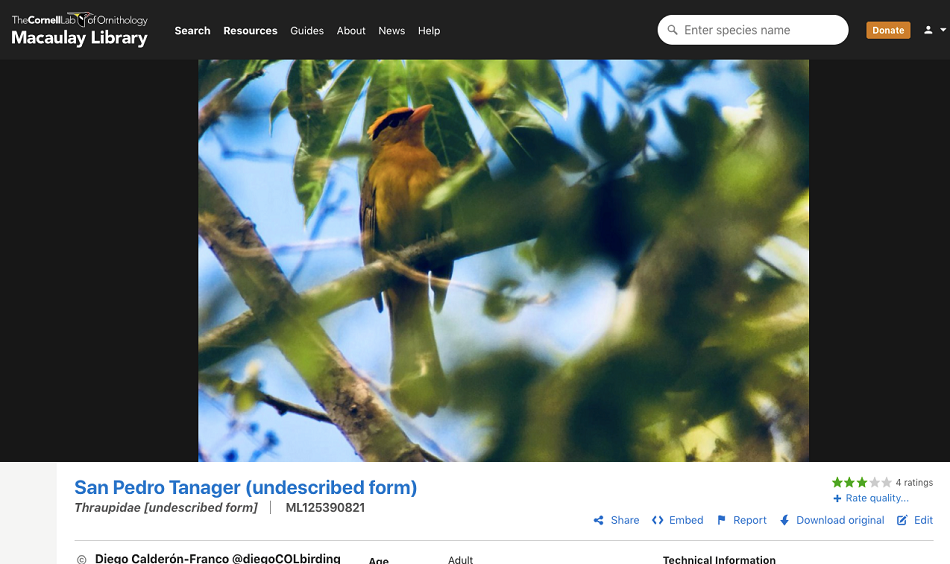
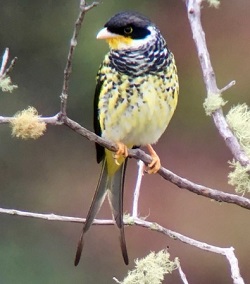 There
are many other bird species
here including Yungas
Antwren, the threatened
Military Macaw, and Rufous-vented
Ground-Cuckoo. The large
rain shadow dry forest
is a fairly unique ecosystem
and offers many bird
species more common to
Chaco and dry forests
south of Santa Cruz city
like Ochre-cheeked Spinetail,
Rufous Casiornis, Black-capped
Antwren, Black-bellied
Antwren, and Saffron-billed
Sparrow. But also because
of its highland location
the area shares species
of Andean river valleys
and middle montane forests
like Yungas Manakin,
Plain Antvireo, Pale-edged
Flycatcher, White-winged
Tanager, Two-banded and
Golden-crowned Warbler.
There
are many other bird species
here including Yungas
Antwren, the threatened
Military Macaw, and Rufous-vented
Ground-Cuckoo. The large
rain shadow dry forest
is a fairly unique ecosystem
and offers many bird
species more common to
Chaco and dry forests
south of Santa Cruz city
like Ochre-cheeked Spinetail,
Rufous Casiornis, Black-capped
Antwren, Black-bellied
Antwren, and Saffron-billed
Sparrow. But also because
of its highland location
the area shares species
of Andean river valleys
and middle montane forests
like Yungas Manakin,
Plain Antvireo, Pale-edged
Flycatcher, White-winged
Tanager, Two-banded and
Golden-crowned Warbler.
Our
multi-day tour allows
time to track down
the
tanager. We'll
also look for
Palkachupa
(Apolo) Cotinga (DC)
and
Green-capped
Tanager in the Bolivian
Andean Cerrado and
other
birds in the Apolo
Yungas
such as Yellow-crested
Tanager, Round-tailed
Manakin, Red-stained
Woodpecker, Mottle-backed
Elaenia, Black-capped
Antwren, Yungas Tyrannulet,
Yungas Antwren, Bolivian
Recurvebill, Inambari
Woodcreeper, Ocellated
Piculet, White-bellied
Pygmy-Tyrant, and
perhaps
even Scimitar-winged
Piha are all possible
in the area.
ITINERARY
Day
1:
Today
we will set off for
Charazani birding
along the way and breaking
up the long journey
to Apolo.
Day
2 – 5: This morning
we will continue on
to Apolo, Bolivia where
we will spend 4 nights.
Our
days will be spent
searching for the Inti Tanager
and other specialties.
Day
6:
Return
to La Paz.
Day
7:
Transfer to La Paz/El
Alto International Airport
(Code: LPB) to connect
with international
flights out.
Post-tour
Extension to Apolo for
the Inti Tanager,
November 13 - 19, 2024
Tour
Price:
$1995
pp/dbl,
$295
sgl
from
La
Paz,
Bolivia
Price
based
on
a
minimum
of
8
passengers.
Included: Group
airport
transfers,
accommodations,
meals,
transport
in
local
vehicles
Not
Included: International
flight,
luggage
charges,
passport/visa
fees,
insurance,
drinks,
tips,
and
items
of
a
personal
nature. Also,
any
and
all
costs
arising
from
pandemic
or
Covid-19
related
issues
are
not
included
in
the
tour
cost
and
are
the
sole
responsibility
of
the
traveler.
These
include,
among
others,
the
costs
of
Covid
treatment,
hospitalization,
medical
fees,
transport,
meals
and
accommodation
in
case
of
illness
or
quarantine,
and
the
costs
of
any
Covid
tests
needed
before,
during
and
after
the
tour.
TOUR
CODE - What
to expect TRAVELING
ON
THE BIRDING
TRAIL
ELEVATION
EXPECTED
WEATHER
VEHICLES
WHEN
NATURE CALLS
OTHER
CONCERNS
If you have any questions at all about this tour, please ask [email protected] |
Leader: Diego
Calderon, plus Steve
Bird and Gina Nichol
(with 8 or more clients).
| BOLIVIA October 29 - November 13, 2024 Registration Form> Contact [email protected] to reserve your space! PLUS: Pre-tour Extension to the Barba Azul Nature Reserve/Blue-throated Macaw, October 25 - 30, 2024 PLUS: Post-tour Extension to Apolo for the new INTI Tanager, November 13 - 19, 2024 TOUR PRICES:
Tour
and extension prices
are based on double
occupancy and a
minimum of 8 passengers. Deposit: $1000.00 per person per tour. Note: Tour deposits can be paid by credit card via PayPal. Use this link to make your credit card payment. Please advise [email protected] when you have made payment. Inclusions/Exclusions -- Please see above in tour descriptions.
Please note: Tour prices are based on quoted costs from ground operators (in their local currency), estimated fuel costs, and the rate of exchange at the time of itinerary publication. The erratic nature to global financial markets makes it difficult to predict changes in costs and foreign currency exchange rates over the long term. Since tours are priced well in advance of the actual operation of the tour, tour costs, fuel costs and exchange rates can change, sometimes drastically. Depending on the extent of such changes, it may be necessary to implement a surcharge on this tour. If a surcharge is necessary, every effort will be made to minimize the amount.
Cancellations
and Refunds:
TRIP INSURANCE: PLEASE NOTE
|
Photo credits: SB=Steve Bird, DC=Diego Calderon, GN=Gina Nichol, JS=John Ashworth